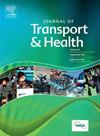Promising results from the short-term evaluation of the RideScore Active Schools program, in Queensland, Australia
IF 3.3
3区 工程技术
Q2 PUBLIC, ENVIRONMENTAL & OCCUPATIONAL HEALTH
引用次数: 0
Abstract
Background
Australian children are not meeting recommended daily physical activity and active school travel targets. To increase active wheeled travel to school, the RideScore Active Schools program used gamification to motivate children's participation and smart app technology to provide parents reassurance of children's arrival to and departure from school. Program reach and RideScore's short-term impact on children's active travel from preparatory year to grade six were evaluated.
Methods
A quasi-experimental design was utilised with eight school sites allocated to the intervention condition and four schools to the comparison condition, in Queensland, Australia. Bicycle and scooter counts were completed at baseline (T1) and four-months later (T2). The school was the unit of observation and analysis. Program reach and children's participation were assessed through registrations, trip numbers, riding frequency, and distance travelled. Data were analysed using regression analysis with heteroskedasticity-consistent standard errors.
Results
From baseline, total bike count increased 38.0 % in intervention schools and decreased 4.3 % in comparison schools. Adjusting for school enrolment, between T1 and T2, intervention relative to comparison schools recorded an average daily increase of 33.6 bikes (p = 0.03), corresponding to an average percentage increase of 55.2 % (p = 0.01). The effect size was moderate (Hedge's g = 0.78). Children travelled a total distance of 88,004 km, corresponding to 12.8 tonnes of CO2 saved. Conditional on assumed travel speeds of 14 km/h and 10 km/hr, commuting contributed 6.5–9.1 min per day to children's physical activity.
Conclusion
RideScore increased active wheeled travel and contributed to primary school children's recommended daily physical activity targets.
澳大利亚昆士兰州的RideScore活跃学校项目的短期评估结果令人鼓舞
澳大利亚儿童没有达到建议的每日体育锻炼和积极的学校旅行目标。为了增加轮式出行上学的积极性,RideScore active Schools项目使用游戏化来激励孩子们的参与,并使用智能应用技术来为父母提供孩子上下学的保证。评估了项目覆盖面和RideScore对预科至六年级儿童主动旅行的短期影响。方法采用准实验设计,将澳大利亚昆士兰州的8所学校分为干预组,4所学校分为比较组。在基线(T1)和4个月后(T2)完成自行车和踏板车计数。学校是观察和分析的单位。通过注册、出行次数、骑行频率和旅行距离来评估项目的覆盖面和儿童的参与度。采用异方差一致标准误差的回归分析对数据进行分析。结果与基线相比,干预学校的自行车总数增加了38.0%,而比较学校的自行车总数减少了4.3%。在T1和T2之间调整学校入学率,相对于比较学校的干预记录平均每天增加33.6辆自行车(p = 0.03),对应于平均百分比增加55.2% (p = 0.01)。效应量为中等(Hedge’s g = 0.78)。孩子们总共旅行了88,004公里,相当于减少了12.8吨二氧化碳。假设交通速度为14公里/小时和10公里/小时,通勤每天为儿童的身体活动贡献6.5-9.1分钟。结论ridescore增加了主动轮式出行,有助于达到小学儿童推荐的每日身体活动目标。
本文章由计算机程序翻译,如有差异,请以英文原文为准。
求助全文
约1分钟内获得全文
求助全文

 求助内容:
求助内容: 应助结果提醒方式:
应助结果提醒方式:


